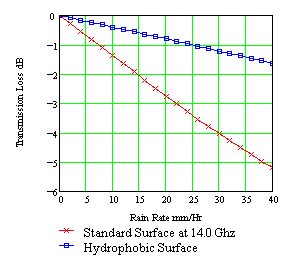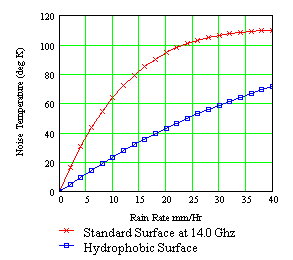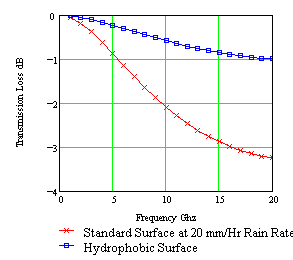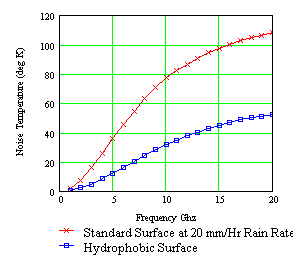 Radome Hydrophobic Surfaces
Radome Hydrophobic Surfaces
Return to DSF Advantages Return to AFC ProfileReturn to Radome Network Home Page
When a radome is subjected to rain, a water film forms over the radome surface. For RF signals passing through the film, power absorption and noise temperature increase in direct proportion to rain rate. To reduce these rain effects, a property known as surface hydrophobicity is enhanced. Good surface hydrophobicity effectively creates a dryer radome --- reducing power loss, additive rain noise temperature and G/T degradation. Further, hydrophobicity significantly reduces ice adhesion.
Various water film thickness buildup and flow mechanisms over radome surfaces were first proposed by D. Gibble at the Bell Telephone Laboratories to account for the increase in radome attenuation at the Andover, Main site. Gibble's work was later disputed by C.C. Mei of MIT for leading to transmission loss results which are to excessive. Mei's analysis accounted for the turbulent water flow over the radome. Even Mei's transmission loss theory proved prohibitively high to account for modern hydrophobic surfaces. In contrast, R.H.J. Cary, on the other hand, proposed a water film thickness mechanism that nearly achieves constant film thickness independent of rain rate. Cary's formulation hints at hydrophobic surfaces that appear dryer by shedding water and puddling. Measurements undertaken by Dr. E. Joy of Georgia Tech. further support Cary's theory. He measured the statistical significance of rain puddle diameters, height and frequency per unit area as a function of rain rate and hydrophobicity. For broad rain rate ranges, Dr. Joy’s results suggest that hydrophobic surfaces continue to behave effectively dryer with increasing rain rate----again approaching a equivalent constant water film thickness. His work clearly identifies the degradation of hydrophobic surfaces as the root cause of increasing rain absorption loss. In AFC's opinion both Cary's and Mei's results bear truth. A radome with a perfect hydrophobic surface, having minimal added rain attenuation calculated by Cary, deteriorates rapidly to Mei's results when the hydrophobic surface degenerates by dirt, abrasion, ultraviolet light and/or corrosive chemicals in our atmosphere.
| Additive Rain Transmission Loss | Additive Rain Noise Temperature |
 |  |
 |  |
Surface chemistry is a unique and complex study. AFC does not profess to be an authority on this subject. However, since our introduction into the radome business, extensive research has been pursued towards a hydrophobic surface. After working with several companies who work with low critical surface energy materials, including Dow Corning and DuPont, we have reached the following conclusions: The only commonly used material capable of achieving 20 ergs/cm2 free surface energy is pure Polytetraflouraethylene (TEFLON ®). However, fluorinated products are very hazardous for use in an industrial environment (ultimately increasing the price of the final product). Products in the Teflon family are typically modified to enhance some specific property, such as bonding ability. Modified Teflon is likely to exhibit a surface energy of 21-23 ergs/cm2, or more. Fumed silicon dioxide coatings exhibit a low surface energy. AFC has seen one such product with a claimed contact angle of 140 degrees. They do, in fact, produce an extremely hydrophobic surface. To date, however the above family of coatings, Vellox for example, is fragile. They are easily rubbed off, and susceptible to some airborne, industrial pollutants. Due to ease of removal, surface products would most likely have to be applied after radome assembly, and reapplied every year.
Members of the silicon family typically achieve free surface energy in the low 20's, 22-23 ergs/cm2. Many silicones remain rubbery, giving a surface which retain some contaminants and subsequently naturally washed away by rain.
The industry "standard" radome coatings, gelcoat, paint and TEDLAR ®, exhibit surface energies in the high 20's when new. They rapidly degrade to a totally wettable surface. Within 2 years after exposure, water removal is accomplished by sheeting. This is the least desirable method. Such materials, without modification, are obviously unacceptable for long term hydrophobicity.
Hydrolam 1000 (Legacy)
AFC has worked extensively with the manufacturer of a proprietary modified silicon coating called Hydrolam 1000. It is most commonly described as a silicon polymer, in that it cross-links with the substrate to achieve a chemical bond. It works well with gelcoat and Tedlar, leaving a hard, water repellent clear surface. Radome surface color is unchanged. The product is abrasion resistant, and inert to all common solvents. The product has a measured water droplet contact angle of 111 to 113 degrees, and a free surface energy of 22-23 ergs/cm2. Weathering data available suggests that the product will last until a sloughing of the substrate occurs. Should this happen, it is easily reapplied in the field.
Hydrolam 2000
Superior hydrophobicity is now obtained with a super-hydrophobic coating exhibiting a water droplet contact angle greater than 130 degrees. The coating is partially opaque and needs to be color matched to any specific requirements of the interior surface color. The surface appearance is textured. A super-hydrophobic coating is not oleophobic and requires some care in handling to prevent oil contamination. Surfaces with a super-hydrophobic coating are effectively dry. Water literally rushes off the surface in fast moving droplets.
Considering performance and cost parameters, Hydrolam 2000 on gelcoat or Tedlar is the superior choice. It is a tough surface and water removal is accomplished by fast moving water droplets and rivulets. The coating should last for years until natural etching occurs from bombardment by our dirty atmosphere.
AFC manufactures, markets and sells worldwide satellite dish antennas, radomes, antenna feeds, microwave and waveguide components and ultra low loss waveguide transmission line Tallguide ®. Our customers serve the broadcast, communications, radar, weather and cable industry, defense, government, and government agencies worldwide. AFC's quality control manufacturing standards are certified under ISO 9001 : 2015.
Return to DSF Advantages Return to AFC Profile Return to Radome Network Home Page
Tel (352) 687-4121 Fax (352) 687-1203 Email sales@afcsat.com
Tallguide is a Registered Trademark of Antennas for Communications
Teflon is a Registered Trademark of Dupont
Tedlar is a Registered Trademark of Dupont
Copyright © 1996 - 2020 Antennas for Communications